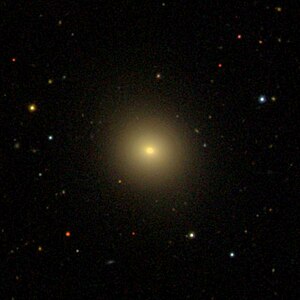NGC 4956
| Galaxy NGC 4956 |
|
|---|---|

|
|
| SDSS recording | |
| AladinLite | |
| Constellation | Hunting dogs |
|
Position equinox : J2000.0 , epoch : J2000.0 |
|
| Right ascension | 13 h 05 m 00.9 s |
| declination | + 35 ° 10 ′ 41 ″ |
| Appearance | |
| Morphological type | S0 |
| Brightness (visual) | 12.3 mag |
| Brightness (B-band) | 13.3 mag |
| Angular expansion | 1.5 ′ × 1.5 ′ |
| Surface brightness | 13.5 mag / arcmin² |
| Physical data | |
| Affiliation | LGG 329 |
| Redshift | 0.015844 ± 0.000070 |
| Radial velocity | 4750 ± 21 km / s |
|
Stroke distance v rad / H 0 |
(214 ± 15) · 10 6 ly (65.6 ± 4.6) Mpc |
| history | |
| discovery | Wilhelm Herschel |
| Discovery date | May 1, 1785 |
| Catalog names | |
| NGC 4956 • UGC 8177 • PGC 45236 • CGCG 189-017 • MCG + 06-29-025 • 2MASX J13050097 + 3510413 • GC 3395 • H II 413 • h 1525 • LDCE 943 NED001 | |
NGC 4956 is a 12.3 likes bright lenticular galaxy of Hubble type S0 in the constellation Canes Venatici on the northern sky . It is estimated 214 million light years away from the Milky Way and has a diameter of about 95,000 ly. Together with NGC 4986 , IC 4189 , PGC 45937 and PGC 45410 , it forms the small galaxy group LGG 329.
In the same area of the sky are among others the galaxies IC 4171 , IC 4178 .
The object was discovered on May 1, 1785 by Wilhelm Herschel with an 18.7-inch reflector telescope, who described it as "pB, S, R, bM and very suddenly fainter on the edges".
NGC 4956 group ( LGG 329 )
| Galaxy | Alternative name | Distance / million Lj |
|---|---|---|
| NGC 4956 | PGC 45236 | 214 |
| NGC 4986 | PGC 45538 | 217 |
| IC 4189 | PGC 45336 | 217 |
| PGC 45937 | UGC 8199 | 221 |
| PGC 45410 | UGC 8200 | 214 |
